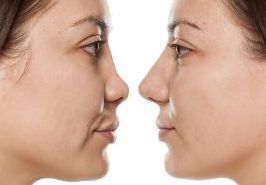
Dr. Menachof, MD, FACS has performed thousands of facial plastic surgery procedures in over 20 years of experience. He has been recognized as a Fellow by multiple academies, named one of America’s Top Facial Plastic Surgeons continually since 2003 and is featured in multiple national publications.
Most of us have the ability to flare our nostrils, but some people’s nostrils are more pronounced when smiling, inhaling, laughing or when static and at rest. There are solutions to reducing nostril flares, no matter when your nostril flaring is most prominent.
What Is Nasal Flaring?
Is flaring your nostrils genetic?  Permanently flared nostrils, or flared nostrils when at rest, can be genetic or they can be caused by previous nasal surgery (see below). Naturally flared nostrils are often the result of your genetic makeup, but the physical ability to flare your nostrils is not genetic.
Permanently flared nostrils, or flared nostrils when at rest, can be genetic or they can be caused by previous nasal surgery (see below). Naturally flared nostrils are often the result of your genetic makeup, but the physical ability to flare your nostrils is not genetic.
In this image, you can see the nostril flare is a widening of the nostril cartilage.
What Is the Treatment to Reduce Nostril Flaring?
There are surgical and non-surgical solutions to reshaping the nostrils, whether they flare at rest or while smiling or laughing. It’s important to have an in-person consultation to determine your nostril reduction needs, as everyone’s nasal configuration is different.
Flared Nostrils Rhinoplasty
Open rhinoplasty is the solution for those who have a flaring nostrils genetic makeup. When the patient is at rest, and the patient has flared up nostrils, rhinoplasty is the permanent solution to reshape the nostril. Rhinoplasty is an operation for static flared nostrils – not flaring nostrils during excessive breathing or laughing.
Trimming the muscles that cause the lateral pull of the nostrils can decrease their flaring. In this open rhinoplasty procedure, these muscles are accessed by an incision in the base of the columella. The thinning of these muscles provides support to the nasal tip while also bringing the nostrils in towards the midline. This incision is usually invisible.
Alar Base Reduction
If you relax your face and look straight ahead, and the width of the base of your nostrils is what’s causing them to flare, then an alar base reduction is the solution for you.
To avoid scarring, an alar base reduction is a closed approach. The incision is on the inside of the nostril, and is called a Weir incision. A wedge-shaped piece of nostril wall is removed, narrowing the nostril width and reducing the flare.
An alar base reduction decreases the nostril flaring and / or decreases the overall size of the nostrils. It is important to know that smile muscles can cause the nostrils to flare, even after an alar base reduction is performed. Flared nostrils surgery corrects nostril flaring for static facial expressions.
Tip Rhinoplasty
If the flared nose is due to nasal tip cartilage, a tip rhinoplasty should be considered. In this case, the tip cartilage can be trimmed and reshaped to relieve excess curvature. Reshaping the tip can make the nostril edges straighter, reducing nostril flare. Open or closed approaches can be considered for this procedure.
Botox
Nasal flare when smiling is normal, but if it is excessive, this should be improved with Botox, a temporary solution. Botox improves the dynamic action of nostril flaring, not static nostril flaring.
There are muscles that pull the nasal tip down and pull the nostrils laterally. By injecting a few units of Botox into specific areas around the nose, the pull of these muscles will be softened, reducing the nostril flare.
Each injection would only need two to three units, a small amount, making this option the cheapest solution. Botox would need to be repeated twice or three times a year.
Flared Nostrils After Rhinoplasty
While you do expect some swelling after a rhinoplasty procedure, flared nostrils are usually not related. If you have flared nostrils after a rhinoplasty, it is likely that your surgeon did not account for the accompanying change in nostril shape.
Part of the preoperative planning for a rhinoplasty is recognizing that if you make the nose smaller, you will have to account for the nostril flaring and therefore reduce the nostril size as a part of the procedure. If the size of the nose changes, but the nostril size does not, they can have a flared appearance. It is also possible that the contoured nasal tip is not projecting as far, causing the base of the nose to settle, creating nostril flaring.
Don’t panic. This type of nasal flaring can be corrected by any of the flared nasal surgery procedures above. If the incisions are closed carefully, the scars will be unnoticeable, and you will achieve your desired nasal appearance.
If you are concerned with your nasal flaring, don’t hesitate to reach out to an experienced facial surgeon. He or she will evaluate your flared nose and create a plan of action to help you accomplish your nasal goals.
This blog was originally posted in March of 2018 and has been reposted in 2020 with updated information.




